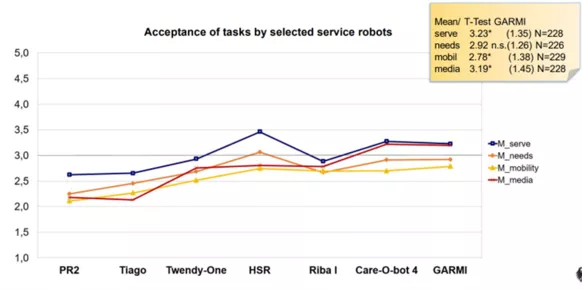In a further analysis, researcher Jahn will explore how the structural design and appearance of specific robots and robot groups affect their acceptance.
Robotics Design Study at MIRMI: Care Robots in Demand as Service Providers
NEWS, Health, Robotics |
How do people respond to the care robot GARMI from the Geriatronics Research Center in Garmisch-Partenkirchen, and how does it compare to other care robots? These are the two sets of questions that researcher Eva Theresa Jahn from MIRMI has focused on over the past two years within the KoBo34 research project.
First Survey: Focus on the Care Robot GARMI
The first survey took place during the robotics exhibition KI.Robotik.Design at the Pinakothek der Moderne in Munich. The MIRMI care robot was present during the survey, allowing the 250 participants to get a direct impression of it:
- Elderly people view GARMI as a versatile helper: Older individuals (51 years and older) responded positively to GARMI regarding the potential tasks a care robot could undertake, while younger people were somewhat more reserved. Whether it's about support in household tasks (Serve), more physically close services like massage, hygiene, and dressing (Needs), assistance in mobility such as getting up and going to bed (Mobility), or the use of media like video, telephone, alarm functions, or the internet (Multimedia), the older respondents gave GARMI consistently high average ratings of nearly 4.0 on a scale from 1 (negative) to 5 (positive).
- People with caregiving experience find GARMI more likable than other participants: Those with caregiving experience generally found GARMI more likable than respondents without caregiving experience. During the survey, it became evident that the head and face of GARMI were perceived as the most likable body parts, while the arms and base were considered average. This could be attributed to "caregivers being heavily engaged in their profession and hoping for support from a care robot," says researcher Jahn.
- High acceptance, particularly in the 51+ age group: The 51+ age group considers the care robot GARMI suitable, especially in hospitals and care centers. Acceptance levels decrease somewhat when it comes to using GARMI at home in general or relying on it for personal support.
Second Survey: GARMI Compared to Other Care Robots
In a second survey during the robotics exhibition at the Deutsches Museum in Munich, researcher Jahn interviewed students and visitors about their impressions of various robots. Exactly 500 different robots were evaluated and rated by the participants based on images. For a separate analysis, Jahn selected six care robots comparable to GARMI.
- Care-O-Bot and GARMI rank highest in likability: Regarding likability, GARMI and the Care-O-Bot from the Fraunhofer Institute for Manufacturing Engineering and Automation (IPA) performed best. Interestingly, younger individuals (under 25 years) rated the robots as more likable, while older individuals were more reserved. Researcher Jahn attributes this to the assessment being made without the participants being able to see and experience the robot in person. "Movement and the robot's voice, along with direct interaction, would likely influence the results," says Jahn, who distributed over 5,000 questionnaires for the survey and received over 2,700 usable responses so far.
- Toyota's HSR seen as the best household assistant: In terms of acceptance for specific tasks, GARMI and the Care-O-Bot ranked at approximately the same level. Here, the areas of Serve and Media were the most accepted. However, there is still skepticism when it comes to more personal tasks (Mobility). Notably, Toyota's Human Support Robot (HSR) did not rank high in likability but scored very well in terms of acceptance, despite having only one arm. "Possibly, the reputation of the Toyota company and the very simple black-and-white design play a role in the evaluation," Jahn speculates.

Receive our featured stories, news, events, and videos in your inbox every month, subscribe here!




